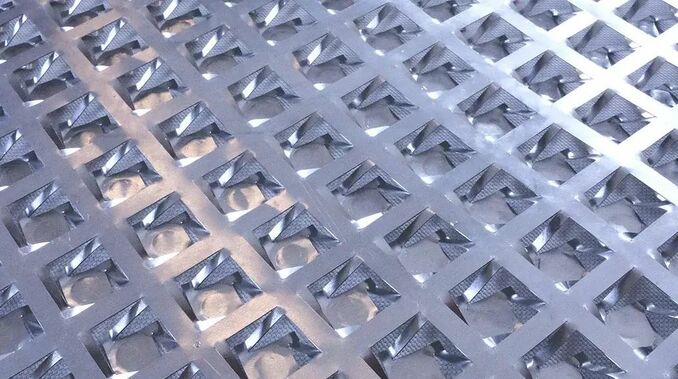
A bird bone becomes the model for a revolutionary idea in metal construction. Dr. Maximilian Scherff was looking for a lightweight heat sink for photovoltaic solar modules when he came across the structure of an animal bone. He took its properties and stability as a model for an innovative metal structure. The result is a lightweight sandwich element that not only saves 60 percent in weight, but can also be used for many other industrial applications.

© Matrix Modules
The idea is based on the bionic stiffening principle of a bird’s bone, inside which there are fine bone webs that support the thin bone shell. This structure is transferred to a metal sheet using simple stamping processes, in which the bone webs are replaced by stable sheet metal strips known as necto elements.
Together with another sheet, the Necto sandwich is formed. The elements are designed in such a way that there is virtually no cutting loss during the production process, and the size and packing density of the elements can vary over the sandwich surface. This makes it easy to adjust the stability of the sheet structure to the load. The sandwich consists of only two parts and is very well suited for functional integration due to the variable and open sandwich core.
Due to the low elongation during the manufacturing process, sheets with high tensile strengths can be used.
Winner is …
In 2018, Matrix-Module GmbH together with the Fraunhofer Institute for Solar Energy Systems (FhG-ISE) successfully won first place at the Fraunhofer Venture Startup Competition Tandemcamp. The following year, the Necto idea was the winner in the start-up competition “Start2Grow” of the Dortmund Economic Development Agency and the team won the German start-up competition “Salon des Créateurs” at the Start-up Ruhr Area competition in December 2019. The 2021 team also reached the finalist round of the Altair Enlighten Award with their idea.

© Matrix Modules
Solar modules
The first product of Matrix-Module GmbH was developed specifically for the photovoltaic market. The newly developed module frame with Necto elements is formed from a single sheet of metal and then glued to the back of the PV modules.
Compared to the usual aluminium frames, this is cheaper to manufacture and the module is much stiffer and flatter. The packing density of the modules increases by 50 percent and the glass thickness of the solar modules can also be reduced, making them 5 kg lighter.
Following various laboratory tests, field tests are currently being conducted worldwide in cooperation with various solar module manufacturers who are interested in using this panel.
New areas of application
Another application example is an engine hood for a historic sports car, which was created using hybrid construction. Instead of an aluminium outer skin, one made of CFRP was connected to the Necto element made of aluminium. This combination saved 60 percent of the weight. The hood weighs only 6 kg and is very torsion-resistant.
It is easier to implement completely unmixed components. There is also a very wide range of joining techniques to choose from, as the joining points of the sandwich are accessible from both sides.
About Matrix Modules
Matrix-Module GmbH was founded in December 2019 by Dr.-Ing, Patent-Ing. Maximilian Scherff, Dipl.-Ing. Jörn Suthues and M.Sc. Henning Busse. The three have known each other since their time together at Q-Cells SE and together have been active in research and development for five decades.
Maximilian Scherff developed the world record PV module at Q-Cells in 2015. Henning Busse has already received several awards for his various module developments, and Jörn Suthues founded Wavelabs Solar Metrology Systems GmbH in 2011 and successfully led it as CTO until the founding of Matrix.
Matrix-Module GmbH is completely owned by the founders and aims to make the innovation usable for a wide range of applications by granting licenses. Thus, in addition to solar modules, other applications in building construction and car body construction are currently being tested and discussed.
The team has many more ideas and is sure that many more innovative applications will be found. That is why the company is looking for partners in order to discover further fields of application together with them.
